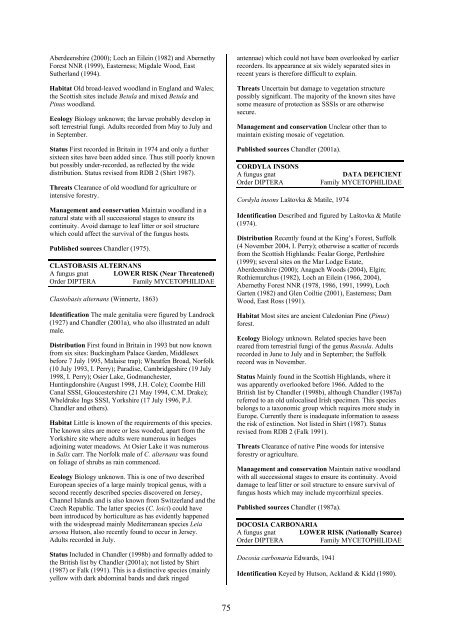Part 2: Nematocera and Aschiza not dealt with by Falk (1991) - JNCC
Part 2: Nematocera and Aschiza not dealt with by Falk (1991) - JNCC
Part 2: Nematocera and Aschiza not dealt with by Falk (1991) - JNCC
Create successful ePaper yourself
Turn your PDF publications into a flip-book with our unique Google optimized e-Paper software.
Aberdeenshire (2000); Loch an Eilein (1982) <strong>and</strong> Abernethy<br />
Forest NNR (1999), Easterness; Migdale Wood, East<br />
Sutherl<strong>and</strong> (1994).<br />
Habitat Old broad-leaved woodl<strong>and</strong> in Engl<strong>and</strong> <strong>and</strong> Wales;<br />
the Scottish sites include Betula <strong>and</strong> mixed Betula <strong>and</strong><br />
Pinus woodl<strong>and</strong>.<br />
Ecology Biology unknown; the larvae probably develop in<br />
soft terrestrial fungi. Adults recorded from May to July <strong>and</strong><br />
in September.<br />
Status First recorded in Britain in 1974 <strong>and</strong> only a further<br />
sixteen sites have been added since. Thus still poorly known<br />
but possibly under-recorded, as reflected <strong>by</strong> the wide<br />
distribution. Status revised from RDB 2 (Shirt 1987).<br />
Threats Clearance of old woodl<strong>and</strong> for agriculture or<br />
intensive forestry.<br />
Management <strong>and</strong> conservation Maintain woodl<strong>and</strong> in a<br />
natural state <strong>with</strong> all successional stages to ensure its<br />
continuity. Avoid damage to leaf litter or soil structure<br />
which could affect the survival of the fungus hosts.<br />
Published sources Ch<strong>and</strong>ler (1975).<br />
CLASTOBASIS ALTERNANS<br />
A fungus gnat LOWER RISK (Near Threatened)<br />
Order DIPTERA<br />
Family MYCETOPHILIDAE<br />
Clastobasis alternans (Winnertz, 1863)<br />
Identification The male genitalia were figured <strong>by</strong> L<strong>and</strong>rock<br />
(1927) <strong>and</strong> Ch<strong>and</strong>ler (2001a), who also illustrated an adult<br />
male.<br />
Distribution First found in Britain in 1993 but now known<br />
from six sites: Buckingham Palace Garden, Middlesex<br />
before 7 July 1995, Malaise trap); Wheatfen Broad, Norfolk<br />
(10 July 1993, I. Perry); Paradise, Cambridgeshire (19 July<br />
1998, I. Perry); Osier Lake, Godmanchester,<br />
Huntingdonshire (August 1998, J.H. Cole); Coombe Hill<br />
Canal SSSI, Gloucestershire (21 May 1994, C.M. Drake);<br />
Wheldrake Ings SSSI, Yorkshire (17 July 1996, P.J.<br />
Ch<strong>and</strong>ler <strong>and</strong> others).<br />
Habitat Little is known of the requirements of this species.<br />
The known sites are more or less wooded, apart from the<br />
Yorkshire site where adults were numerous in hedges<br />
adjoining water meadows. At Osier Lake it was numerous<br />
in Salix carr. The Norfolk male of C. alternans was found<br />
on foliage of shrubs as rain commenced.<br />
Ecology Biology unknown. This is one of two described<br />
European species of a large mainly tropical genus, <strong>with</strong> a<br />
second recently described species discovered on Jersey,<br />
Channel Isl<strong>and</strong>s <strong>and</strong> is also known from Switzerl<strong>and</strong> <strong>and</strong> the<br />
Czech Republic. The latter species (C. loici) could have<br />
been introduced <strong>by</strong> horticulture as has evidently happened<br />
<strong>with</strong> the widespread mainly Mediterranean species Leia<br />
arsona Hutson, also recently found to occur in Jersey.<br />
Adults recorded in July.<br />
Status Included in Ch<strong>and</strong>ler (1998b) <strong>and</strong> formally added to<br />
the British list <strong>by</strong> Ch<strong>and</strong>ler (2001a); <strong>not</strong> listed <strong>by</strong> Shirt<br />
(1987) or <strong>Falk</strong> (<strong>1991</strong>). This is a distinctive species (mainly<br />
yellow <strong>with</strong> dark abdominal b<strong>and</strong>s <strong>and</strong> dark ringed<br />
antennae) which could <strong>not</strong> have been overlooked <strong>by</strong> earlier<br />
recorders. Its appearance at six widely separated sites in<br />
recent years is therefore difficult to explain.<br />
Threats Uncertain but damage to vegetation structure<br />
possibly significant. The majority of the known sites have<br />
some measure of protection as SSSIs or are otherwise<br />
secure.<br />
Management <strong>and</strong> conservation Unclear other than to<br />
maintain existing mosaic of vegetation.<br />
Published sources Ch<strong>and</strong>ler (2001a).<br />
CORDYLA INSONS<br />
A fungus gnat<br />
Order DIPTERA<br />
Cordyla insons Laštovka & Matile, 1974<br />
DATA DEFICIENT<br />
Family MYCETOPHILIDAE<br />
Identification Described <strong>and</strong> figured <strong>by</strong> Laštovka & Matile<br />
(1974).<br />
Distribution Recently found at the King’s Forest, Suffolk<br />
(4 November 2004, I. Perry); otherwise a scatter of records<br />
from the Scottish Highl<strong>and</strong>s: Fealar Gorge, Perthshire<br />
(1999); several sites on the Mar Lodge Estate,<br />
Aberdeenshire (2000); Anagach Woods (2004), Elgin;<br />
Rothiemurchus (1982), Loch an Eilein (1966, 2004),<br />
Abernethy Forest NNR (1978, 1986, <strong>1991</strong>, 1999), Loch<br />
Garten (1982) <strong>and</strong> Glen Coiltie (2001), Easterness; Dam<br />
Wood, East Ross (<strong>1991</strong>).<br />
Habitat Most sites are ancient Caledonian Pine (Pinus)<br />
forest.<br />
Ecology Biology unknown. Related species have been<br />
reared from terrestrial fungi of the genus Russula. Adults<br />
recorded in June to July <strong>and</strong> in September; the Suffolk<br />
record was in November.<br />
Status Mainly found in the Scottish Highl<strong>and</strong>s, where it<br />
was apparently overlooked before 1966. Added to the<br />
British list <strong>by</strong> Ch<strong>and</strong>ler (1998b), although Ch<strong>and</strong>ler (1987a)<br />
referred to an old unlocalised Irish specimen. This species<br />
belongs to a taxonomic group which requires more study in<br />
Europe. Currently there is inadequate information to assess<br />
the risk of extinction. Not listed in Shirt (1987). Status<br />
revised from RDB 2 (<strong>Falk</strong> <strong>1991</strong>).<br />
Threats Clearance of native Pine woods for intensive<br />
forestry or agriculture.<br />
Management <strong>and</strong> conservation Maintain native woodl<strong>and</strong><br />
<strong>with</strong> all successional stages to ensure its continuity. Avoid<br />
damage to leaf litter or soil structure to ensure survival of<br />
fungus hosts which may include mycorrhizal species.<br />
Published sources Ch<strong>and</strong>ler (1987a).<br />
DOCOSIA CARBONARIA<br />
A fungus gnat LOWER RISK (Nationally Scarce)<br />
Order DIPTERA<br />
Family MYCETOPHILIDAE<br />
Docosia carbonaria Edwards, 1941<br />
Identification Keyed <strong>by</strong> Hutson, Ackl<strong>and</strong> & Kidd (1980).<br />
75
















